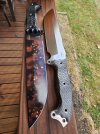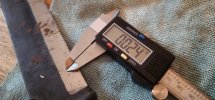beachmaster
Gold Member
- Joined
- Oct 3, 2014
- Messages
- 661
1- edge thickness is not thickness all the way to the edge by any official designation. BTE is Behind The Edge thickness- that is a synonymous with edge thickness.And if true, makes no sense as we are talking about which blade has more thickness all the way to the edge and thus the advantage in strength. Which is the measurement Jerry provided.
Also, since you keep on bringing bte up it is obvious from jerrys pic that it is also thicker bte. And thicker means more edge shoulder support in chopping and thus a stronger edge in favor of the skrama, design wise. But due to INFI being the better steel the Ash2 lasted longer.

2- it may be shown by his graphic if his engineer has a skrama and measured the BTE before making the graphic. It isn't shown by the graphic if they did not and the BTE is listed as an assumed and equal measurement.
My Battle Mistress is supposed to come in by 9pm tonight (I doubt that'll happen, it'll be tomorrow) in which case I will mic both and post the measurements first thing. (I'm way stoked)



